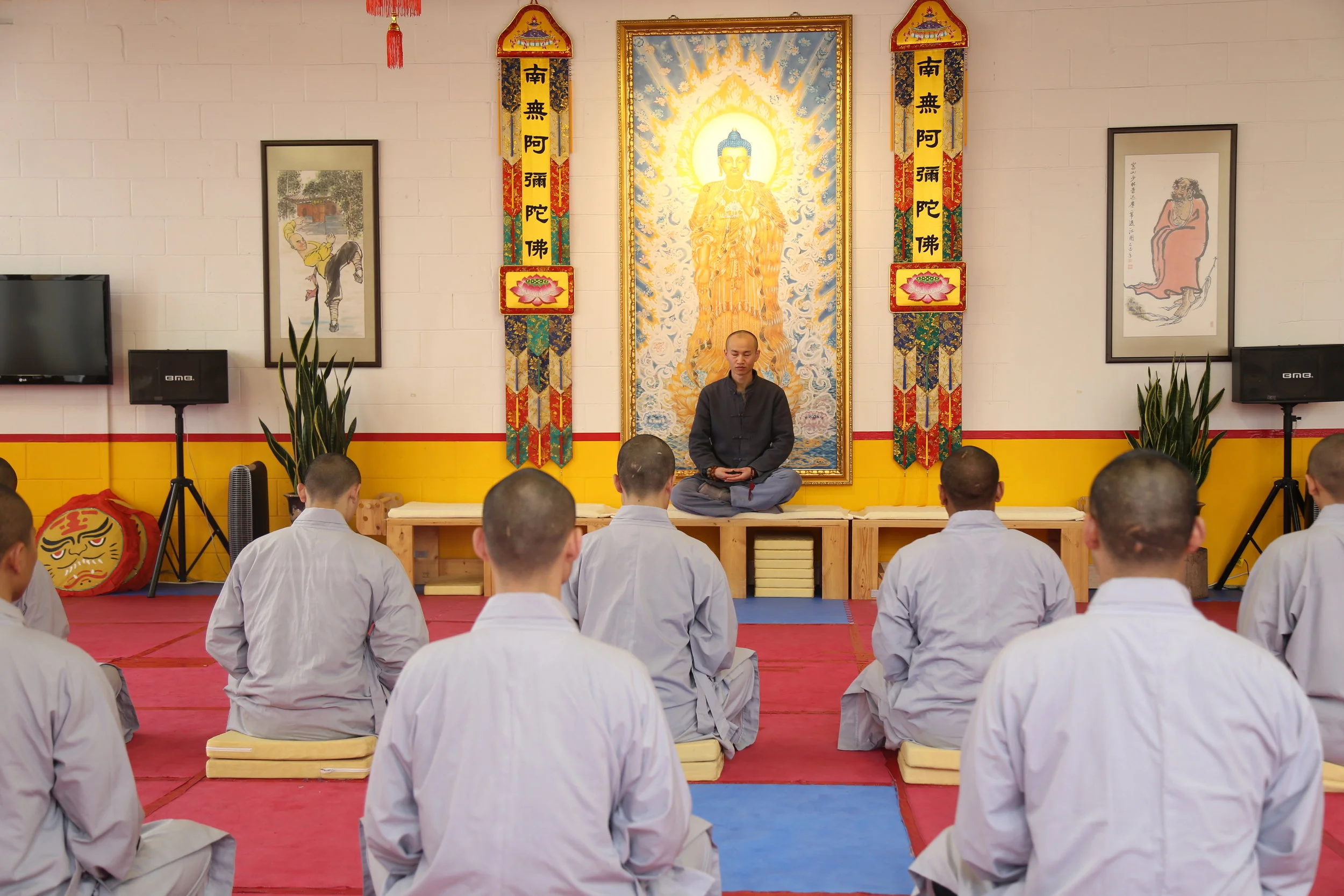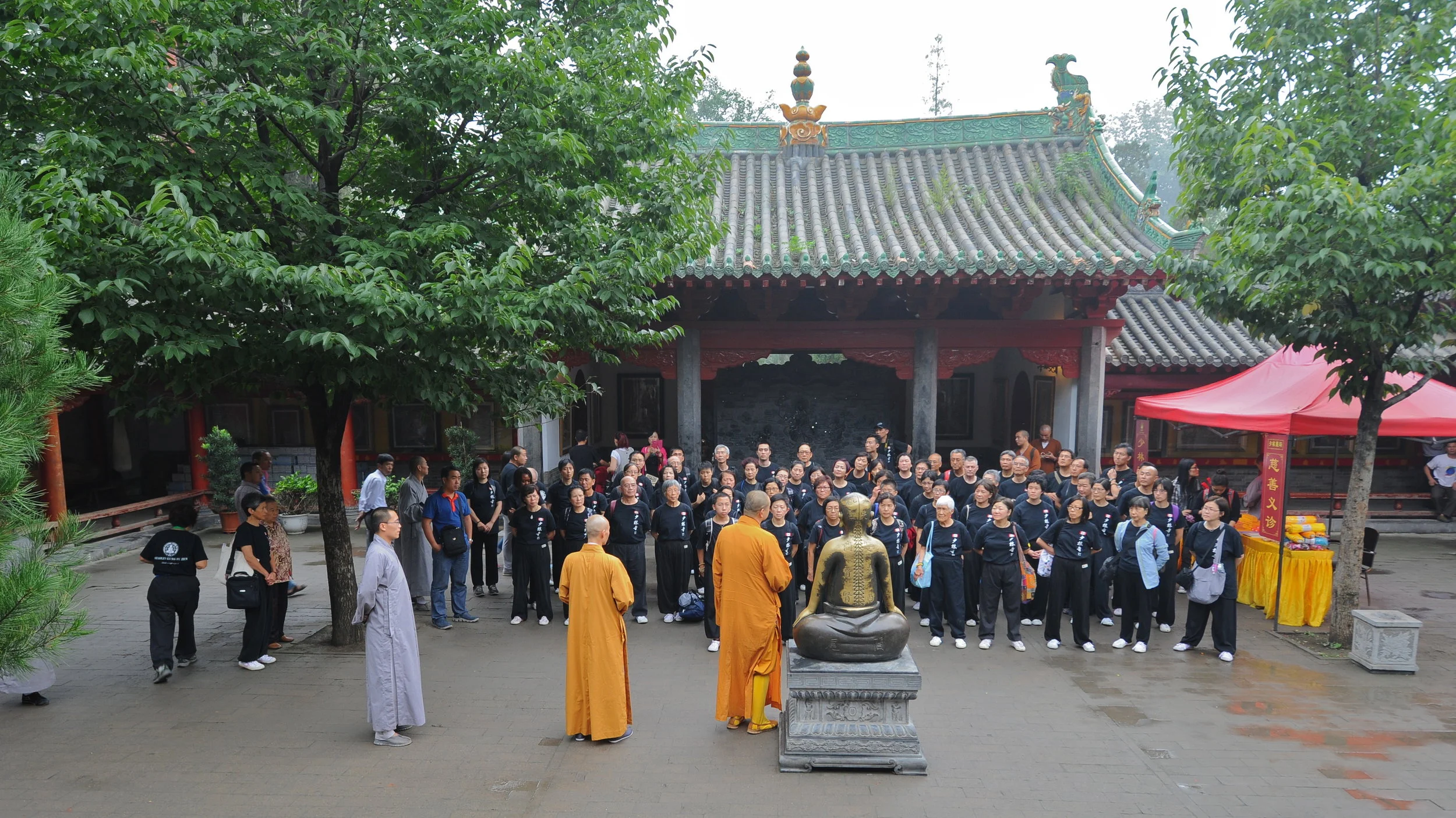


Zen (Chan) 禅
少林禅
Zen (Chan) 禅
少林禅
Bodhidarma was the 28th patriarch of Indian Buddhism. After he settled down in Shaolin Monastery, he practised meditation in concealment in a stone cave in the vicinity of the monastery for nine years. There he sank into perennial meditation until he completed his formulation of the system of Zen tenets, which is based on dhyana. Therefore he is acclaimed as the 1st patriarch of the Zen sect. The name of his successor is Huiko, reputed as the 2nd patriarch. Huiko was succeeded by Sengcan as the 3rd patriarch. Daoxin was conferred the title of the 4th patriarch after Sengcan's death. Then Hongren became the 5th patriarch, who was succeeded by Huineng as the 6th patriarch. Brilliant talents and charismatic personalities of these six paramount leaders of the Zen set combined to open out an unrestrained development of the Zen sect in China. After the 6th patriarch, five schools diverged out of the Zen sect which was at that time the largest and most powerful Buddhist sect in China.
In the parlance of the Zen sect, "Zen" means "meditation". According to Yogacara, "meditation is such a mentality, in which one makes his cogitation focus on a point by first seeking to rid his mind of all impertinent and straying thoughts." In vernacular terms, dyana (which was later transmuted into Zen of Chinese Buddhism) may be interpreted as a system of theories, which was evolved for the purpose of inducing a dhyana devotee to concentrate his mental activities on ruminating just one topic. In the case of Zen , once a Zen devotee has developed the habit of concentrating or controlling his mind at will, a new mental faculty would be created in him. To develop such a habit, a devotee may try either of the two methods of "breath-counting concentration" and "introspective concentration". Either method is intended for enabling a devotee who practices Zen tenets to control his mental activities at will. The Zen doctrine requires a Zen devotee to become not only completely blind, deaf, and benumbed to all his surroundings but also completely placid inwardly when he is in a perfect state of meditation.Therefore practising Zen entails virtually very straining mental exertion and, if such mental exertion is valid, can create a sort of mental subtlety in a Zen practitioner.
The basic doctrines adhered to by the Shaolin school of the Zen sect are completely in line with the basic doctrines formulated by Buddha himself. The policy laid down by patriarchs in the history of the Zen sect for propagating Zen basic doctrines is unique and independent. The ultimate goal expected to be reached by a devotee of the Shaolin school is his final discovery of his svabhava through the Zen transcendental meditation regularly performed by him. Besides, the Shaolin school of the Zen sect distinguishes itself from other schools of the Zen sect in its adherence to the principle of integrating doctrinal inculcation of the Zen tenets with Shaolin Kung Fu training. So far as the monk population of Shaolin Monastery is concerned, their primary task is receiving education in Zen and practising meditation. They have a secondary task to fulfill too, which is undergoing Shaolin Kung Fu training. In order to practise meditation properly a Shaolin monk needs to regulate his mind by banishing from it all thoughts so that he can have peace of mind fit for receiving Zen inculcation and practising meditation. On the other hand he has to keep himself fit so that he can carry on his primary task of pursuing Zen tenets study and practising meditation well. For that purpose he must receive Shaolin Kung Fu training. However, in no circumstances he is allowed to make progress in Kung Fu training at the cost of his achievement in Zen tenets study or meditation. Zen is the source of life, vitality, and wisdom. At the base of the universe does rest Zen.

Zen Medicine 医
少林医
Zen Medicine 医
少林医
In more than 1500 years’ legacy of Shaolin culture since the establishment of Shaolin Temple in 495AD, Shaolin Medicine has become an intangible cultural heritage of mankind with authenticity, peculiarity and uniqueness. As one of the most outstanding representatives of excellent Chinese culture, it has strong international appeal.
Buddhist medicine is an indiscerptible part of Buddhism and enjoys an extremely high status in the history of the Eastern medicine. It is a medicine which can really treat both root causes and symptoms. Sakyamuni, also called the Great Healer, had spent nearly four years in instructing Buddhist Medical System, with the aim to relieve the sentient beings from the sufferings of illness and to make it an important tool for disseminating Buddhism. The ingenious combination of the medicine of Chinese Buddhism and folk traditional Chinese medicine makes the distinctive Buddhist Medicine of China, such as Traumatology of Shaolin Temple and Gynecology of Zhulin Temple, etc. Among them Shaolin Traumatology School is the most representative and most influential.
Shaolin Medicine originated in the Wei and Jin Dynasties (220-581), and has a history of over 1000 years. After the development in the Tang and Song Dynasties (618-1279), it finally took shape in the Ming Dynasty (1368-1644), and was enriched and improved in the Qing Dynasty (1616-1911). The Shaolin Medicine has a close relationship with the development of Shaolin Kung Fu. Most prominent Shaolin monks in history were versed in Chan, Kung Fu and Medicine, which is known to the world. For example, Tanzong and Huiyang in the Tang Dynasty (618-907), Fuju and Zhiguang in the Five Dynasties (907-960), Shiyan and Zongfa in the Yuan Dynasty, Yuekong, Zhizheng and Zhichun in the Ming Dynasty, Meiting in the Qing Dynasty. From the late Ming Dynasty, there are Chunji, Jiqin, Zhenhou, Zhenxu, Henglin, Miaoyue, Chande, etc. Their prescriptions are usually based on the theories of Chinese traditional medicine, which is an indispensable part of Chinese Traumatology.
A famous historian of the Yuan Dynasty, Yuan Haowen, wrote in his Story Shaolin Pharmacy Bureau: Shaolin Pharmacy Bureau dates back from the Jin Dynasty (1217), thus has a history of more than 800 years. The Pharmacy Bureau at that time was primarily used for treating the traumatic injuries and other diseases of Shaolin monks. Later it mainly served the local people and those who came from far away. Due to the fact that all the treatment and medicines were free, the patients would donate money after the curing of diseases. Shaolin Pharmacy Bureau has various ways to cure diseases or keep fit, such as the famous Yi Jin Xi Sui Jing and Shaolin Neigong. There are also many secret recipes handed down by eminent monks for promoting health and longevity or curing diseases. By the period of the Republic of China, Shaolin Medicine had got treatises on medicine of millions of words, and thousands of prescriptions, which are seldom transmitted to outsiders due to Buddhist precepts.
Yuan Haowen stated that the praiseworthy part of Shaolin Pharmacy Bureau is its inheritance of medical ethics more than the non-transmission to outsiders. Shaolin Chan Kung Fu and Shaolin Chan Medicine are transmitted from generation to generation without decline. By the compassionate morality and the pursuit of excellence, they finally earn the respect from the world and enable themselves to be the precious intellectual treasures of Shaolin Temple. In the past 800 years, Shaolin Pharmacy Bureau has benefited numerous people. Nevertheless, it was suspended occasionally in history because of the warfare or other reasons.
When master Fuyu served as the abbot of Shaolin Temple, he advocated the principle of “taking the traumatology department as the centre, and internal department, department of pediatrics as supplements to cure the diseases and save people”, which enables the Shaolin Pharmacy Bureau to see a flowering of creativity. In the Ming Dynasty, relatively complete medical institute and medical system were established; pharmacy department (in charge of gathering medical herbs and planting and processing of medical herbs) was set up; meanwhile, medicine school was founded to educate specialized monk doctors. In modern times, due to the declining of the nation, the affairs of the bureau were suspended for a period.
In recent years, under the leadership of Abbot Shi Yong Xin, Shaolin Temple has organized the monks and experts on Chinese medicine to conduct many organizing and mining work. After three years’ efforts, the rare edition of Secrets of Shaolin Kung Fu and Medicine finally came out which contains Shaolin secret recipes handed down from the 29th Venerable Abbot Xing Zheng to Venerable Abbot Yong Xin before the former passed away. The book now has become the permanent collection of National History Museum, National Library and Swedish king. In 2004, Shaolin Temple resumed the organizational system of Shaolin Pharmacy Bureau, since when the bureau has been providing medical services with featured Buddhist compassionate spirit for more sentient beings so as to make due contributions to the human health. It takes the inheritance of Shaolin medicine culture as its mission, the promotion of traditional medicine as its responsibility and serving the society as the purpose.
Shaolin Chan Medicine combines traditional Shaolin Medicine with modern medicine so as to better protect these treasures and benefit people. It takes “meditation” as the basic means, employs the doctrines of respiration, Daoyin, Qixue, meridians and collaterals and viscera-state as main theories, and adopts the approaches of “contemplation”, “aeration”, “massage” to diagnose, treat and nurse the patient. All of these can generate a unique health effect. The most distinctive feature of Chan Medicine is to eliminate the root cause of the delusion and find the Buddha-nature through experiencing Chan heart and cultivating pure mind.



